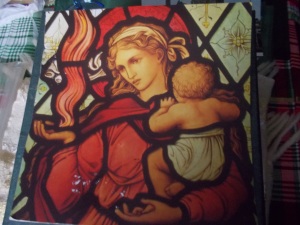I was given the opportunity to help a grieving family with the arrangements for their loved one’s funeral and that was finished last night–at least my part was finished. Today I have turned my face toward the end of January and the coming of Imbolc.
I got out my box o’ Brigid this afternoon and help the wool I’d gathered at the Sliev na Cailleach and smelt the bit of turf from the ancient remnant of the fire temple in Kildare Town. I dumped a bag of newly-woven Wheels onto my dining room table and found the piece of white cotton cloth that is an old soft sheet from my maternal grandmother.
I pulled that out and smoothed it on the table and felt the weight of its history and life–at least the part of its life when it was a carefully-ironed bed sheet spread onto my grandmother’s queen-sized bed.
I took a piece of it with me on my first trip to Ireland and it has been my bhrat each Imbolc since. It will go outside on Friday night–even if I have to hold it down with a rock–and it will receive Brigid’s blessing through the early dew. I will use strips of it for clouties and for healing work for the next year. Until next Imbolc.
Clouties, as I often proudly explain, are the prayer-flags of my people. They are strips of cloth that are tied near sacred wells or on holy thorn trees or left on altars. They hold the wishes, the intentions, the prayers of the person who tied them and tradition has it that when the fabric has rotted away and fallen into the well or off the tree, the prayer is answered.
To be fair, they leave a terrible mess at these holy places and the good hearts who tend the afore-mentioned wells and trees sometimes grumble about the mess that is left by the fervent visitors and their rotting strips of cloth.
I always choose a plain cotton, not patterned, quiet, simple, clean. I tend to wrap all my prayers for a particular thing or time into one clouty, so as to leave room for all those other prayers.

You must be logged in to post a comment.